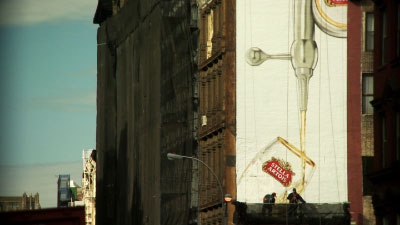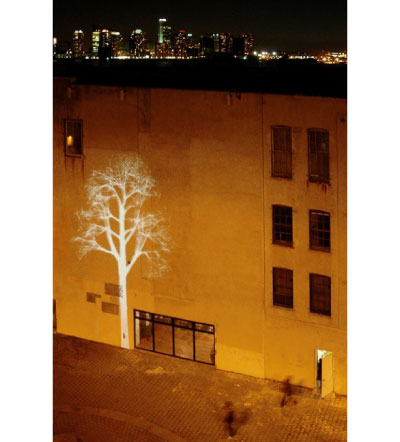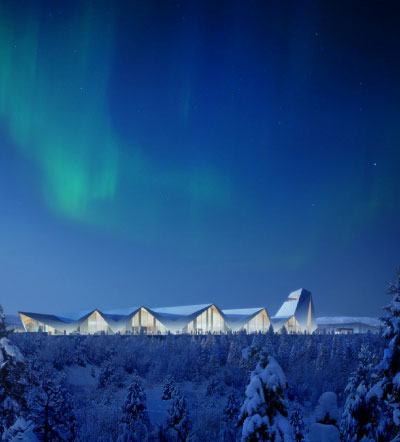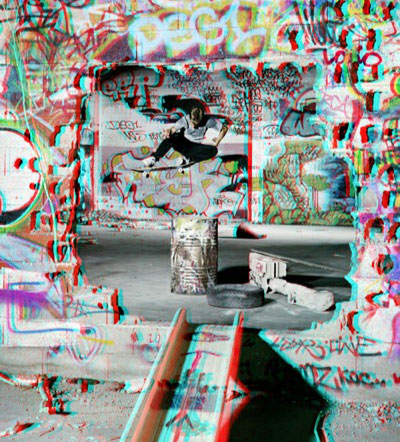

Film and Photography courtesy of Malcolm Murray.


In an era in which advertising presents itself to us in almost every form of media possible, it seems billboards have to contain something special in order to make us look up. Enter the Ritual Project, an exploration of the dwindling hand-painted billboard trade, and
Up There, a short documentary that explores the painstaking execution of a hand-painted 20×50-foot billboard in New York City.
Up There is a testament to the dying art of hand-painted advertisements. “We’re in the vast minority”, says one painter, “Just about everything is done on vinyl, which is printed”. The painters are not interested in instant gratification — evidenced by their completion of a requisite two-year apprenticeship before even being allowed to put paintbrush to brick. The work is both artistically challenging and physically grueling; industry veterans show off warped knuckles resulting from decades of braving the elements. “It takes so much work that it’s kind of ridiculous”, one painter admits. But compared to the pixelated gloss of the more popular vinyl ads, the rich colors that emerge from their own painstaking process make the result well worth the effort. As one artist notes, “It’s the same way Michelangelo did the Sistine Chapel”.
Watch the full documentary after the jump.
(more…)

Tree: copyright Simon Heijdens and slowLab

Though the pithy proverb of The Tortoise and the Hare entered our collective cultural lexicon long ago, the increasingly rapid digital age has made it somewhat difficult to believe that slow and steady can triumph in any endeavor. For an organization like
slowLab, however, taking first place in any competition is merely tangential to a much broader goal. Dedicated to promoting slow design and the six principles it embodies — to reveal, expand, and evolve while encouraging viewers to reflect, engage, and participate — slowLab is the brainchild of director Carolyn Strauss. Founded in 2003, the slowLab prototype focused on slow dialogues, or public discussion forums that elaborated on the notion of “reflecting more, reacting less”.
Since then, the nonprofit organization has supported several projects that embody the ethos of slowLab’s defining principles. A “shining example” of slow design, according to Strauss, is former filmmaker Natalie Chanin’s lifestyle brand, Alabama Chanin. Instead of cycling through trends and seasons to turn a quick profit, Alabama Chanin challenges the fashion industry’s breakneck pace by producing sustainable, hand-stitched garments in Chanin’s hometown of Florence, Alabama. “I was initially drawn to her work because of how it honors and has revived local traditions,” says Strauss. Alabama Chanin’s products are all sewn by local women in traditional communication-fostering work circles, which in turn has also created jobs in a rural region.
(more…)

Photography courtesy of Imaging Atelier. (Click images to enlarge)

When an Oslo-based architectural firm committed to “boldness” and “innovation” joins creative forces with the “international outlook” of a young London firm, it seems likely that their collaborative efforts will favor universal appeal over landscape-specific subtlety. Judging by the concept sketches and feasibility report presented by Narud Stokke Wiig Architects and Planners and Haptic, however, the firm’s proposed design for a Norwegian international airport located just below the Arctic Circle manages to fit both criteria.
Avoiding the harsh juxtaposition of a thoroughly modern structure against the backdrop of an otherwise remote and forested region, NSW and Haptic have instead molded their sharp lines to mimic the local terrain. Shoving the terminal building’s roof into a series of jagged peaks, the design pays homage to the nearby mountains of Traena, with a control tower enclosed within the structure’s tallest peak.
The Nordland, Norway airport certainly isn’t the first of its kind to take inspiration from the surrounding landscape. Yet similar structures like the Denver International Airport, known for its peaked white tensile fiberglass roof reminiscent of the Rocky Mountains, supplement their visual tribute to the environment with sustainable design and environmentally sound materials. Since 2008, DIA has vastly reduced its annual carbon emissions with a massive on-site solar energy system.
(more…)

SCENE 3, Gabriel Engelke (Switch Ollie) © Sebastian Denz

Spend a few hours at a local skate park, and it becomes clear that the dynamism of the halfpipe’s gravity-defying techniques often gets lost in translation from reality to a two-dimensional photograph. Long confined to the realm of motion picture spectacles, German photographer Sebastian Denz uses 3-D imagery to capture “a hybrid space that is in between virtual and real,” one kickflip at a time. Armed with a custom built apparatus assembled by camera specialist Dr. Kurt Gilde, Denz has been on the road with streetwear brand Carhartt’s European skateboard team for the past three years, capturing the athletes in “hyper-reality.” Unlike the comfort of a dark theater, however, these spatial photographs are not about audience passivity, but rather “creating [one's] own construction of reality within these spaces” – a far cry from, say, the lush escapism of Pandora in IMAX.
Carhartt Presents Skateboarding.3D is on display at the Carhartt store in Rome from May 7 through May 26.



 In an era in which advertising presents itself to us in almost every form of media possible, it seems billboards have to contain something special in order to make us look up. Enter the Ritual Project, an exploration of the dwindling hand-painted billboard trade, and Up There, a short documentary that explores the painstaking execution of a hand-painted 20×50-foot billboard in New York City.
In an era in which advertising presents itself to us in almost every form of media possible, it seems billboards have to contain something special in order to make us look up. Enter the Ritual Project, an exploration of the dwindling hand-painted billboard trade, and Up There, a short documentary that explores the painstaking execution of a hand-painted 20×50-foot billboard in New York City.



 Facebook
Facebook Permalink
Permalink Digg
Digg Reddit
Reddit LinkedIn
LinkedIn StumbleUpon
StumbleUpon Tumblr
Tumblr





